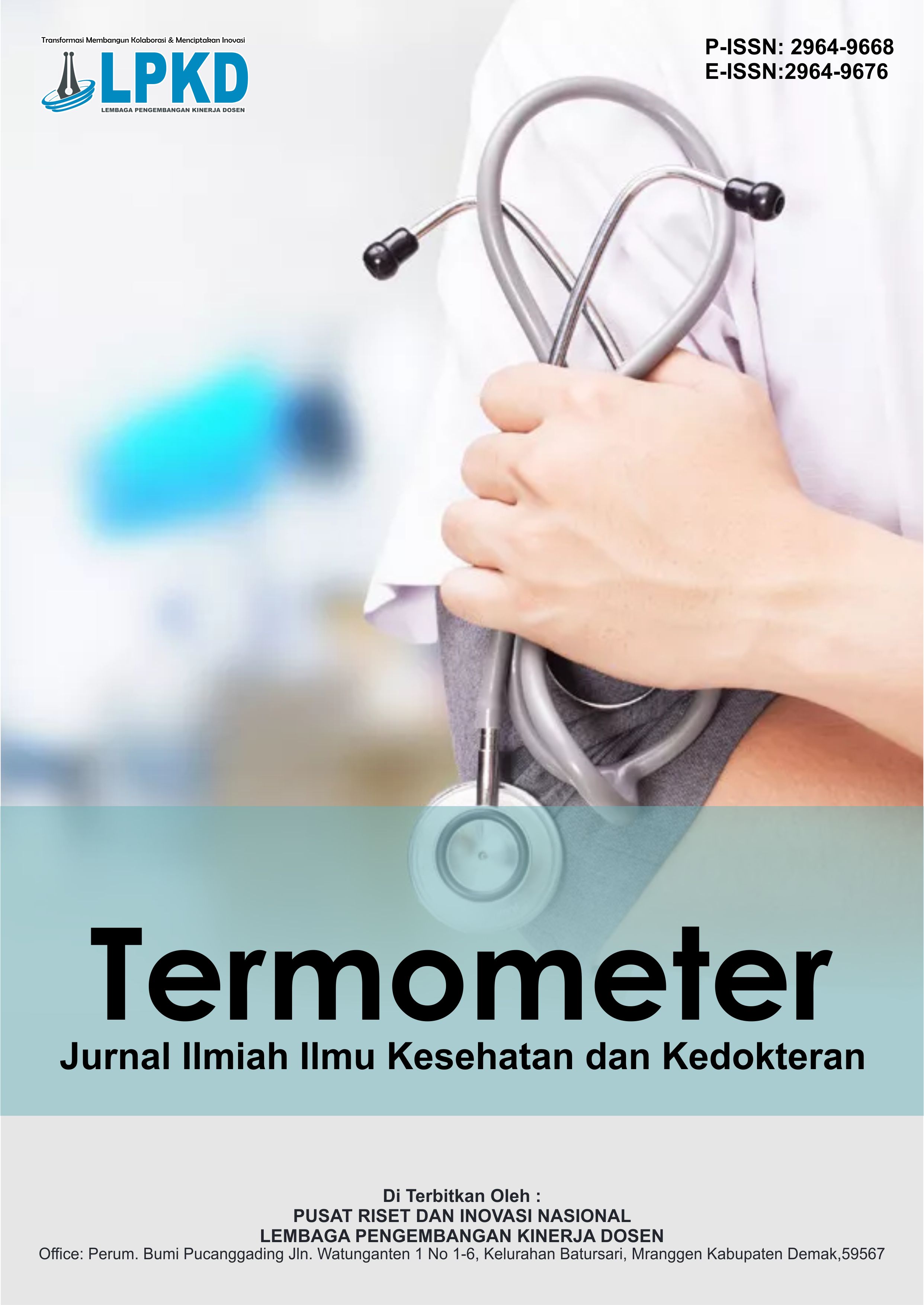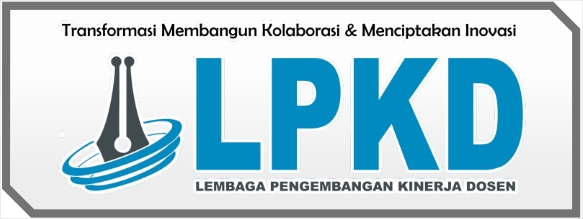Demensia : Patofisiologi, Faktor Resiko dan Peran Inflamasi dalam Perkembangan Penyakit
DOI:
https://doi.org/10.55606/termometer.v3i1.4801Keywords:
dementia, aging, inflammation, ageAbstract
Dementia is a complex neurodegenerative syndrome characterized by cognitive decline, including memory impairment, difficulty in thinking, and social interaction, which can affect daily activities. This condition is often caused by other diseases, including Alzheimer’s disease, vascular dementia, Lewy body dementia, and frontotemporal dementia, each with unique pathological mechanisms. Alzheimer’s disease, the leading cause of dementia, involves the accumulation of beta-amyloid plaques and tau tangles that disrupt neuronal function and trigger chronic inflammation. Vascular dementia results from impaired blood flow to the brain, while Lewy body dementia is associated with the misfolding of alpha-synuclein protein. Meanwhile, frontotemporal dementia is linked to the accumulation of tau or TDP-43 proteins, causing degeneration of the frontal and temporal lobes. Aging is the primary risk factor for dementia through the process of inflammaging, a low-grade chronic inflammation caused by persistent activation of the immune system. Inflammaging accelerates neurodegeneration by increasing oxidative stress, mitochondrial dysfunction, and the accumulation of pathological proteins. Additionally, neuroinflammation plays a crucial role by over activating microglia, which exacerbates neuronal damage. The combination of inflammation as both a trigger and a consequence create a pathological cycle that accelerates the progression of dementia. Preventive strategies include managing modifiable risk factors such as hypertension, diabetes, obesity, and adopting a healthy lifestyle, alongside developing therapies targeting inflammaging and neuroinflammation. A deeper understanding of these pathophysiological and inflammatory mechanisms is essential to support the development of multidisciplinary interventions to reduce the global burden of dementia.
Downloads
References
Andronie-Cioara, F. L., Ardelean, A. I., Nistor-Cseppento, C. D., Jurcau, A., Jurcau, M. C., Pascalau, N., & Marcu, F. (2023). Molecular Mechanisms of Neuroinflammation in Aging and Alzheimer’s Disease Progression. International Journal of Molecular Sciences, 24(3). https://doi.org/10.3390/IJMS24031869
Artemyeva, O. V., & Gankovskaya, L. V. (2020). Inflammaging as the basis of age-associated diseases. Medical Immunology (Russia), 22(3), 419–432. https://doi.org/10.15789/1563-0625-IAT-1938
Ashrafian, H., Zadeh, E. H., & Khan, R. H. (2021). Review on Alzheimer’s disease: Inhibition of amyloid beta and tau tangle formation. International Journal of Biological Macromolecules, 167, 382–394. https://doi.org/10.1016/J.IJBIOMAC.2020.11.192
Boutajangout, A., & Wisniewski, T. (2014). Tau-Based Therapeutic Approaches for Alzheimer’s Disease - A Mini-Review. Gerontology, 60(5), 381–385. https://doi.org/10.1159/000358875
Cabrera, C., Vicens, P., & Torrente, M. (2021). Modifiable Risk Factors for Dementia: The Role of Gut Microbiota. Current Alzheimer Research, 18(13), 993–1009. https://doi.org/10.2174/1567205018666211215152411
De Reuck, J. (2020). Mixed dementia: a neuropathological overview. Diagnosis and Management in Dementia: The Neuroscience of Dementia, Volume 1, 3–15. https://doi.org/10.1016/B978-0-12-815854-8.00001-X
Farina, N., Jacobs, R., Turana, Y., Fitri, I., Schneider, M., Theresia, I., Docrat, S., Sani, T. P., Augustina, L., Albanese, E., Comas-Herrera, A., Toit, P. Du, Ferri, C. P., Govia, I., Ibnidris, A., Knapp, M., & Banerjee Background, S. (2023). Comprehensive measurement of the prevalence of dementia in low- and middle-income countries: STRiDE methodology and its application in Indonesia and South Africa. BJPsych Open, 9(4), e102. https://doi.org/10.1192/BJO.2023.76
Field, T. (2024). Dementia Disorders: A Narrative Review. Journal of Clinical Psychology and Neurology Citation: Tiffany Field, 2(1), 1–7. https://doi.org/10.61440/JCPN.2024.v2.11
Gorelick, P. B., Counts, S. E., & Nyenhuis, D. (2016). Vascular cognitive impairment and dementia. Biochimica et Biophysica Acta, 1862(5), 860–868. https://doi.org/10.1016/J.BBADIS.2015.12.015
Hartnell, I. J., Blum, D., Nicoll, J. A. R., Dorothee, G., & Boche, D. (2021). Glial cells and adaptive immunity in frontotemporal dementia with tau pathology. Brain : A Journal of Neurology, 144(3), 724–745. https://doi.org/10.1093/BRAIN/AWAA457
Heneka, M. T., van der Flier, W. M., Jessen, F., Hoozemanns, J., Thal, D. R., Boche, D., Brosseron, F., Teunissen, C., Zetterberg, H., Jacobs, A. H., Edison, P., Ramirez, A., Cruchaga, C., Lambert, J.-C., Laza, A. R., Sanchez-Mut, J. V., Fischer, A., Castro-Gomez, S., Stein, T. D., … Riechers, S.-P. (2024). Neuroinflammation in Alzheimer disease. Nature Reviews Immunology 2024, 1–32. https://doi.org/10.1038/s41577-024-01104-7
Hennessee, J. P., Katen, C. D., Monier, S. A., & Park, D. C. (2023). Dementia Risk Factors Predict Individual Differences in Cognitive Function. Alzheimer’s & Dementia, 19(S22), e077346. https://doi.org/10.1002/ALZ.077346
Heston, M. B., Hanslik, K. L., Zarbock, K. R., Harding, S. J., Davenport-Sis, N. J., Kerby, R. L., Chin, N., Sun, Y., Hoeft, A., Deming, Y., Vogt, N. M., Betthauser, T. J., Johnson, S. C., Asthana, S., Kollmorgen, G., Suridjan, I., Wild, N., Zetterberg, H., Blennow, K., … Ulland, T. K. (2023). Gut inflammation associated with age and Alzheimer’s disease pathology: a human cohort study. Scientific Reports 2023 13:1, 13(1), 1–12. https://doi.org/10.1038/s41598-023-45929-z
Juul Rasmussen, I., Rasmussen, K. L., Nordestgaard, B. G., Tybjærg-Hansen, A., & Frikke-Schmidt, R. (2020). Impact of cardiovascular risk factors and genetics on 10-year absolute risk of dementia: risk charts for targeted prevention. European Heart Journal, 41(41), 4024–4033. https://doi.org/10.1093/EURHEARTJ/EHAA695
Kalaria, R. N., Akinyemi, R., & Ihara, M. (2016). Stroke injury, cognitive impairment and vascular dementia. Biochimica et Biophysica Acta, 1862(5), 915–925. https://doi.org/10.1016/j.bbadis.2016.01.015
Koren, S., Galvis-Escobar, S., & Abisambra, J. F. (2020). Tau-mediated dysregulation of RNA: Evidence for a common molecular mechanism of toxicity in frontotemporal dementia and other tauopathies. Neurobiology of Disease, 141. https://doi.org/10.1016/J.NBD.2020.104939
Koss, D. J., Erskine, D., Porter, A., Palmoski, P., Menon, H., Todd, O. G. J., Leite, M., Attems, J., & Outeiro, T. F. (2022). Nuclear alpha-synuclein is present in the human brain and is modified in dementia with Lewy bodies. Acta Neuropathologica Communications, 10(1), 1–18. https://doi.org/10.1186/S40478-022-01403-X/FIGURES/4
Kosyreva, A. M., Sentyabreva, A. V., Tsvetkov, I. S., & Makarova, O. V. (2022). Alzheimer’s Disease and Inflammaging. Brain Sciences, 12(9). https://doi.org/10.3390/BRAINSCI12091237
Levy, J. P., Bezgin, G., Savard, M., Pascoal, T. A., Finger, E., Laforce, R., Sonnen, J. A., Soucy, J. P., Gauthier, S., Rosa-Neto, P., & Ducharme, S. (2022). 18F-MK-6240 tau-PET in genetic frontotemporal dementia. Brain : A Journal of Neurology, 145(5), 1763–1772. https://doi.org/10.1093/BRAIN/AWAB392
Nordestgaard, L. T., Christoffersen, M., & Frikke-Schmidt, R. (2022). Shared Risk Factors between Dementia and Atherosclerotic Cardiovascular Disease. International Journal of Molecular Sciences, 23(17). https://doi.org/10.3390/IJMS23179777
Peña-Bautista, C., Kumar, R., Baquero, M., Johansson, J., Cháfer-Pericás, C., Abelein, A., & Ferreira, D. (2023). Misfolded alpha-synuclein detection by RT-QuIC in dementia with lewy bodies: a systematic review and meta-analysis. Frontiers in Molecular Biosciences, 10. https://doi.org/10.3389/FMOLB.2023.1193458
Rascovsky, K., Hodges, J. R., Knopman, D., Mendez, M. F., Kramer, J. H., Neuhaus, J., Van Swieten, J. C., Seelaar, H., Dopper, E. G. P., Onyike, C. U., Hillis, A. E., Josephs, K. A., Boeve, B. F., Kertesz, A., Seeley, W. W., Rankin, K. P., Johnson, J. K., Gorno-Tempini, M. L., Rosen, H., … Miller, B. L. (2011). Sensitivity of revised diagnostic criteria for the behavioural variant of frontotemporal dementia. Brain, 134(9), 2456. https://doi.org/10.1093/BRAIN/AWR179
Sehar, U., Rawat, P., Reddy, A. P., Kopel, J., & Reddy, P. H. (2022). Amyloid Beta in Aging and Alzheimer’s Disease. International Journal of Molecular Sciences, 23(21). https://doi.org/10.3390/IJMS232112924
Zlokovic, B. V., Gottesman, R. F., Bernstein, K. E., Seshadri, S., McKee, A., Snyder, H., Greenberg, S. M., Yaffe, K., Schaffer, C. B., Yuan, C., Hughes, T. M., Daemen, M. J., Williamson, J. D., González, H. M., Schneider, J., Wellington, C. L., Katusic, Z. S., Stoeckel, L., Koenig, J. I., … Chen, J. (2020). Vascular contributions to cognitive impairment and dementia (VCID): A report from the 2018 National Heart, Lung, and Blood Institute and National Institute of Neurological Disorders and Stroke Workshop. Alzheimer’s & Dementia : The Journal of the Alzheimer’s Association, 16(12), 1714–1733. https://doi.org/10.1002/ALZ.12157
Downloads
Published
How to Cite
Issue
Section
License
Copyright (c) 2025 Termometer: Jurnal Ilmiah Ilmu Kesehatan dan Kedokteran

This work is licensed under a Creative Commons Attribution-ShareAlike 4.0 International License.










